The previous essay on this blog was called The Amateur Hour and it was mostly about us getting involved in the Israel-Iran conflict and the amateurs currently running our government, but the original title of that essay was A Weapon of Crass Destruction. The second I wrote that down I thought…wait…don’t waste it on a headline.
That’s a cartoon idea.
Pretty simple: you draw Donald Trump with that cutline and you’ve got a cartoon that says the president is: “lacking in sensitivity, refinement or intelligence” (the definition of “crass”) and you’ve also got a nice tie in with our previous misadventure in the Middle East, the search for the imaginary Weapons of Mass Destruction.
Today we’re going to examine what it took to draw that “simple” cartoon because as those of us who do it for a living already know, making something look simple is exceedingly difficult and we get a bit miffed when we tell someone what we do for a living and they assume it’s easy and after we draw one of out “little” cartoons we must spend the rest of the day fly fishing or writing one-act plays or acting as greeters at Walmart which probably would have been my job if I hadn’t made this cartooning gig work out.
And a-way we go…
Step 1. Have An Idea
This is by far the hardest part of creating a cartoon and the way I get ideas is to read the news and doodle on a sketch pad while drinking coffee, but as some perceptive cartoonist once said, the problem with our job is when we do it we look exactly like we’re goofing off.
We’re not.
We’re putting unrelated facts into our heads and waiting for two seemingly unrelated facts to run into each other and hit it off and decide to make whoopee which in this case means create a cartoon idea.
I get up at 5 AM and start reading and drinking coffee and taking notes and it doesn’t take me nearly as long as it used to—back when I still worked at the Kansas City Star I’d start at 6 AM and be happy if I had an idea by noon—mainly because I now know the kind of news item that will make a good cartoon (for me, maybe not anyone else) and the kind that won’t and I’m also much more aware of the art I’m capable of creating and the art that’s beyond my abilities.
I just don’t take as many wrong turns as I used to.
And now a word about ideas and art.
When I came to Kansas City working for the Star was still a big deal and I got a lot of invitations to speak and show my work to live audiences which changed how and what I drew. I was getting to test market my work in front of real people and see what they liked and they responded to cartoons that were simple, quick and punchy and, to be honest, cartoons that were a little mean (history has shown we enjoy seeing someone else get hit in the crotch) and one of the biggest crowd reactions to a cartoon I ever got is when Ronald Reagan had part of his colon removed and I did a cartoon that said he was no longer a complete asshole.
(See? You probably laughed at that. You can’t laugh at sophomoric cartoons and expect me to quit drawing them.)
I couldn’t get that cartoon in the paper and thank God for that or I probably wouldn’t have survived long enough to draw about Clinton, Obama, two Bushes, Biden and Trump.
But seeing a cartoon live in a crowd for a few seconds is completely different than seeing one by yourself in a newspaper and taking your time looking at it and when someone recently called me the best one-panel cartoonist ever I read that very generous remark and thought:
“Lots of people would disagree with that and I’m one of them.”
As a cartoonist I was and am, just OK.
I knew and know what I can do and make work, but the best one-panel cartoonist ever was either Jeff MacNelly or Pat Oliphant and I vote for Jeff because he was a good friend and Pat Oliphant didn’t come to my wedding or do a giant cartoon of all the participants or hand-make a toy wagon with wooden blocks for my first son to play with and Jeff did, so Pat Oliphant can suck on it.
(Still a pretty great cartoonist though.)
As you can see, Jeff was a way better artist than the rest of us and he put a lot of work into his cartoons so if he drew a sailing ship it would include all the rigging and if the cartoon was set in Merlin’s workshop every book would have a funny title and he once told me he envied my simple ideas and ability to bullshit my way through a cartoon background.
Look at that cartoon at the top again and you’ll see what Jeff meant.
The only thing that’s totally in focus is Donald Trump and the cutline, because that’s where I want you to look, the rest of the cartoon is drawn in halftones and shadows and meaningless furniture and curtain designs so you’ll accept that Trump’s in the Oval Office and then focus where I need you to focus.
The main point is punchy and quick and for those of you who enjoyed that complete asshole remark, a little mean.
Step 2. Sketch the Layout
So now you’ve got your cartoon idea, what’s the cartoon’s setting?
Charles Saxon (yet another one-panel cartoonist better than me and I have a long list of cartoonists to choose from) once explained that when he drew a cartoon he thought about the setting first—like he was staging a play—and then added the actors afterwards. Great way to think about it and after I started using Saxon’s layout method, my backgrounds immediately got better.
Here’s another thing to think about:
Americans read from left-to-right and top-to-bottom so if you have something vertical, if at all possible put it on the left – American readers will find it easier to look at because that’s the eye pattern they’re used to – and if you can think of something to put in the foreground and background and leave the point of interest in the middle, the cartoon will have more depth.
Almost forgot (jeez, I’m giving away all my tricks, but at this stage of my career, what else am I going to do with them) cartoons and newspaper are visually busy so anything solid black or solid white will attract the eye and it took me a long time to get the confidence to not draw and let the main character’s suit be a solid block of ink.
Which us brings us to color.
When I was first required to draw color cartoons I totally sucked at it until I saw the work of the French cartoonist Voutch and he’d always use a dominate color which dictated the color to be used on the main point of interest; if the cartoon was mainly blue use orange or yellow, mainly green use red or purple, mainly yellow use purple and red and if you’re completely confused, use brown because that’s neutral.
Kinda looks like shit with everything.
Step 3. Execute the Idea
Here’s the original version of the same cartoon (before I worked on it in Photoshop) and you’ll notice my original idea was to have Trump eating a McDonald’s Quarter Pounder with fries and ketchup everywhere and that leads me to one of my infamous digressions.
WHAT’S HAPPENING TO AMERICA?
So I’m drawing that cartoon and it makes me hungry for a McDonald’s Quarter Pounder so I go get one and tell the girl in the window I want ketchup with my fries which I shouldn’t have to do because it’s pretty much like Baskin-Robbins giving you a handful of ice cream because you forgot to mention you wanted a cone.
And even after I specifically asked for ketchup I didn’t find any in my bag when I got home.
WTF McDonald’s?
According to the internet, last year McDonald’s sales exceeded $130 billion and their net income was $8.223 billion so how much can forcing customers to ask for ketchup and fucking them over if they forget to ask possibly increase their profits?
Get it together, Mickey D.
OK, so originally there was going to be a Quarter Pounder on Trump’s desk, but then I realized readers might be confused and think I was saying the Quarter Pounder was the Weapon of Crass Destruction and if the way I feel after eating one today is any indication, they’re not totally wrong.
So take out the cheeseburger, leave the Coke because I liked the way it balanced the desk top with the phone on the other side.
Next up: shadows.
You’ve got to decide where the light is coming from and to be completely honest I’ll cheat like a motherfucker on this detail. If I need two suns it’s my cartoon universe and there’s going to be light from two different sources. (I bet that guy wants to take back that greatest one-panel cartoonist remark right about now.)
At first I had the light coming from the right and that’s the version you just looked at. But that looked a little bland--what if the light was coming from outside?
But I scanned the first version in case the second version looked like crap because you can’t get that ink off the cartoon if you don’t like it and that’s the kind of lesson you learn from screwing up and having to start all over again.
It’s not my first rodeo or fuck-up or even my first fucked-up rodeo which had to be the time a bucking horse suffered a case of diarrhea as he went bucking past the fans sitting in the front row and gave them more than they bargained for and I did not make that up.
It happened in Folsom which might explain why Johnny Cash got such a bad case of the blues.
So I add the shadows and like that version better, but now I’ve got to get rid of the shadow from the desk that’s on the rug because it’s screwing up the cartoon’s symmetry which is once again centered on Trump behind his desk.
Everything in the cartoon—the drapes, the picture frames, the desk, the panes of glass are visually pushing you to the center of the cartoon and Donald Trump.
Now I’ve got to do cleanup and straighten the borders of the cartoon and erase or paint over the places where the marker ink bled into the wrong area and make the black areas 100% black and then eliminate three layers of color from the cutline—cyan, magenta and yellow—and leave the black layer because if the newspaper’s color registration gets misaligned it makes it look like you have double or triple vision and if I only have black ink on the cutline at the very least, you’ll be able to read the words.
And finally…
Step 4. Make a Black and White Version
According to King Features—the people who distribute my cartoons—about 80% of the time newspapers are going to use the Black and White version because color costs more to print so even though the color cartoons are a lot more fun to draw and look at, the Black & Whiter cartoons are probably more important.
That being the case…
You’ve got to be aware that two colors that contrast nicely might look exactly the same when the cartoon’s turned into Black & White. And now the shadows become even more important because they make the scene much more dramatic.
Today’s Lesson
There are no simple cartoons or stand-up routines or groundballs or magic tricks and the only reason we think something’s simple is someone put a lot of work into making it look simple.
This was a comparatively simple cartoon and even so it took me 1,785 words—wait, make that 1,791 words and counting—to describe it.
And don’t get me started on crowd scenes.
That’s it for today and I’ve got to get going and start greeting people at Walmart. (I like to stay in practice because you never know when people will get tired of this silly trick I’ve learned to do.)
Have a nice weekend.



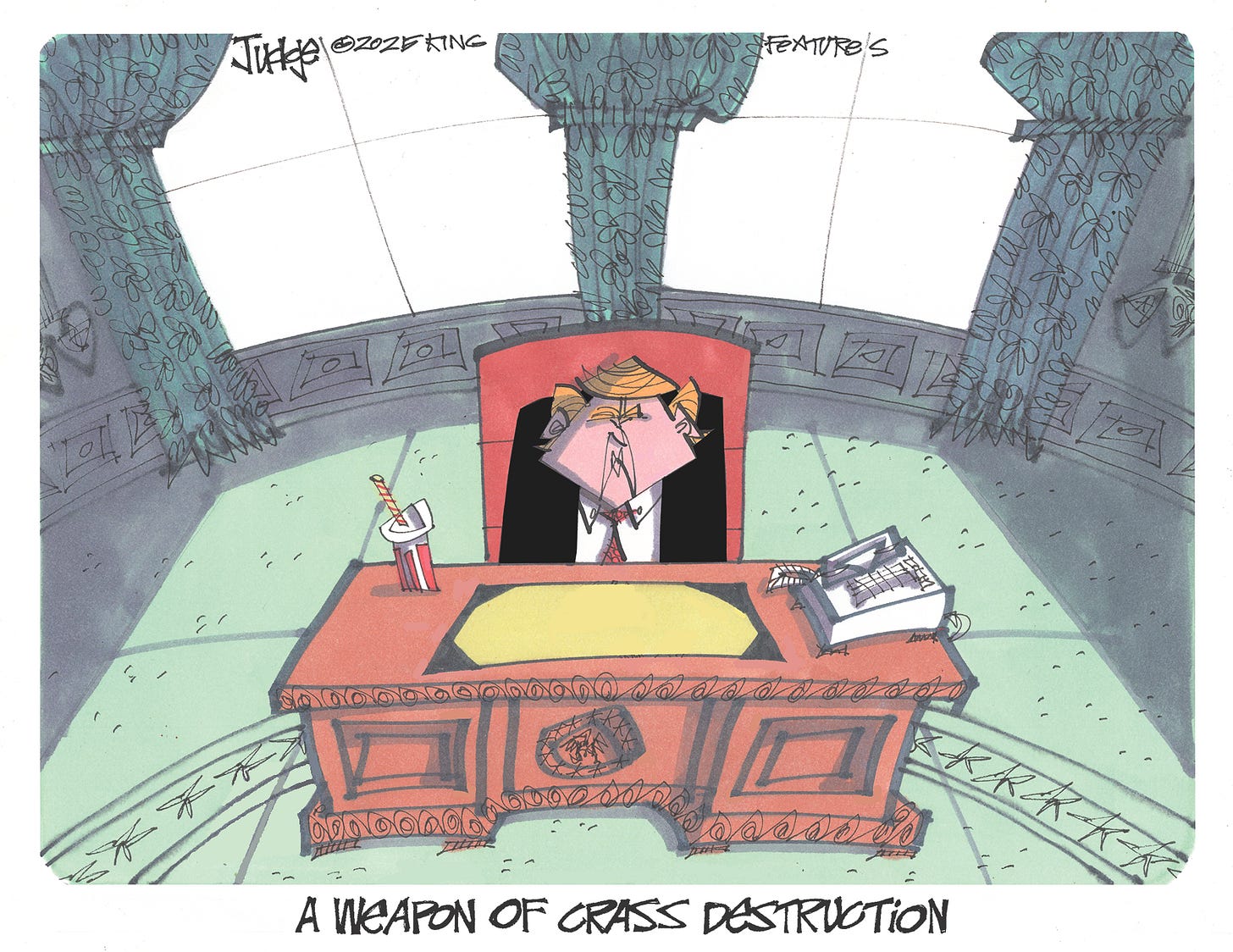
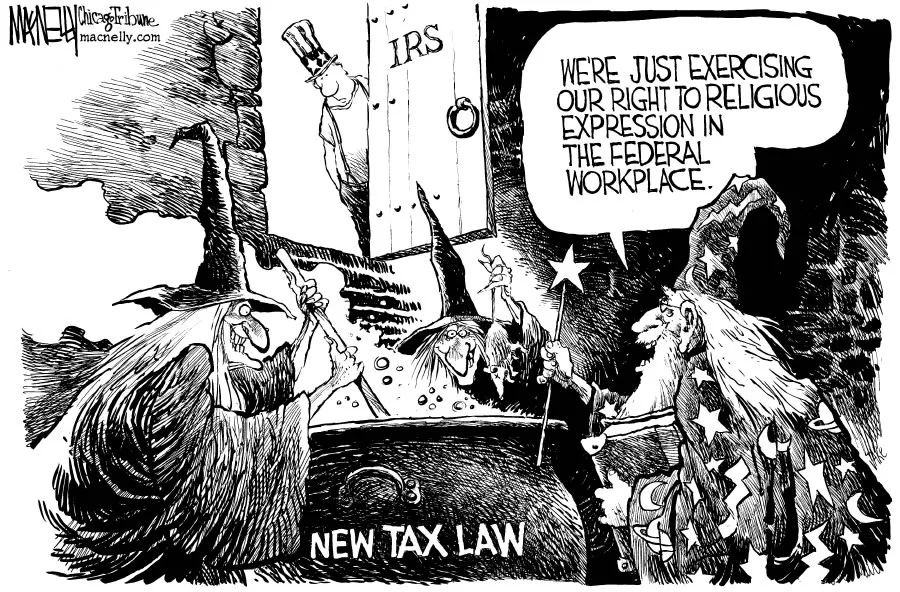
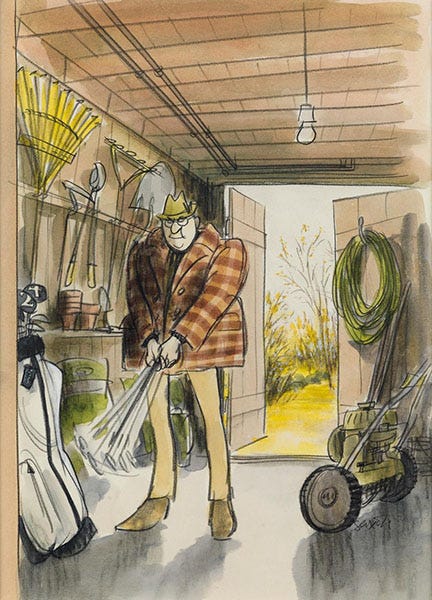
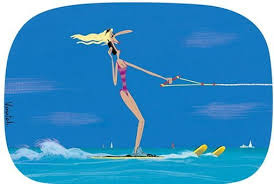


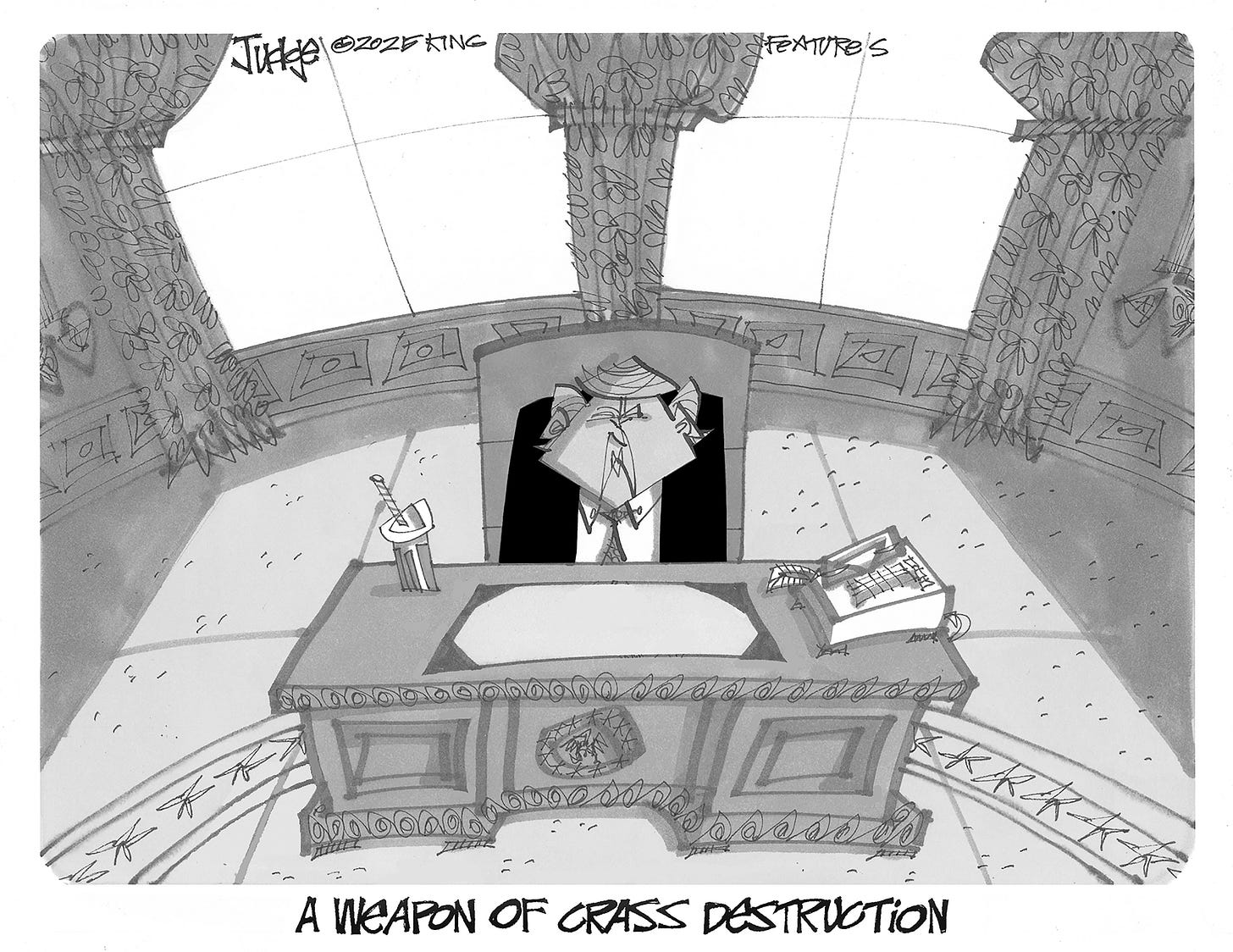
An entertaining take on your process. I will look at cartoons a little differently. I take it for granted that final products for very creative people come easy. Having an idea is only the beginning.
"Weapon of Crass Destruction". Absolutely brilliant!